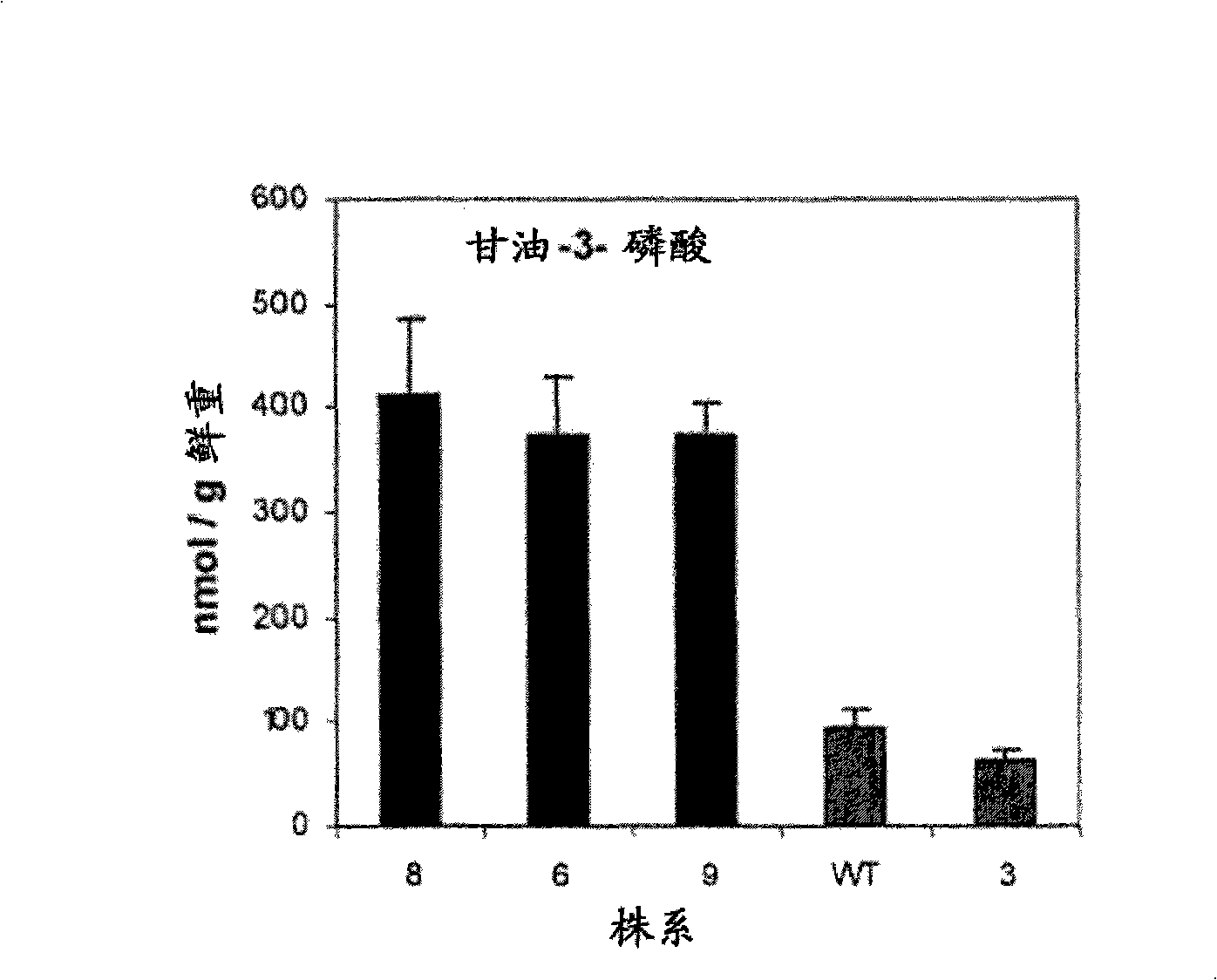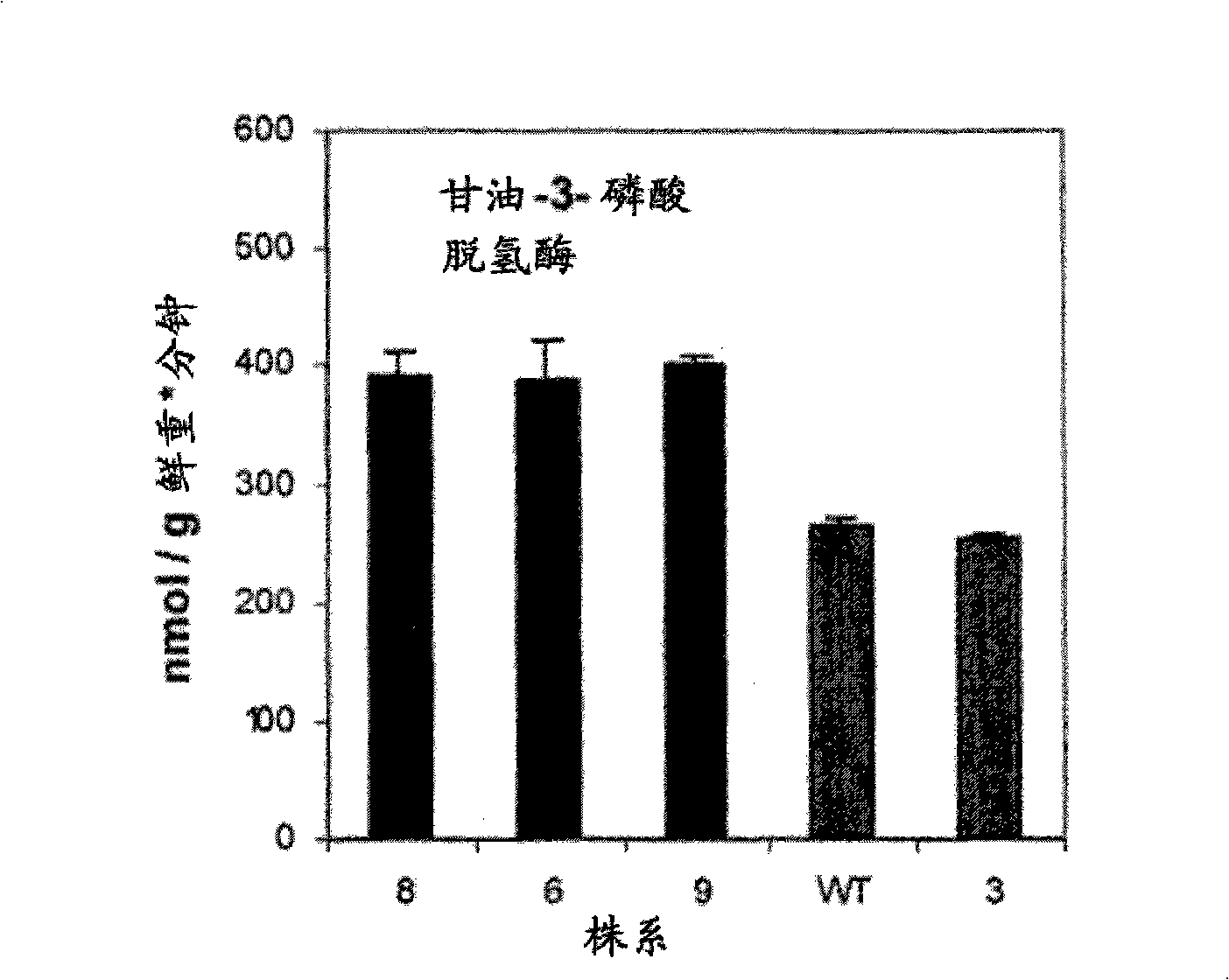Method for increasing the total oil content in oil plants
A technology for oil content and oil crops, which can be applied to biochemical equipment and methods, the use of carriers to introduce foreign genetic material, oxidoreductase, etc., and can solve problems such as increased oil content.
- Summary
- Abstract
- Description
- Claims
- Application Information
AI Technical Summary
Problems solved by technology
Method used
Image
Examples
Embodiment 1
[0214] Example 1: Cloning of yeast Gpd1 gene
[0215] Genomic DNA was isolated from Saccharomyces cerevisiae S288C (Mat alpha SUC2 malmel gal2 CUP1 flo1 flo8-1; Invitrogen, Karlsruhe, Germany) following the protocol disclosed below:
[0216] A 100 ml culture was grown at 30°C to an optical density of 1.0. 60 ml of the culture was centrifuged at 3000 xg for 3 minutes. Resuspend the pellet in 6 ml double distilled HO 2 O, and the suspension was divided into 1.5ml containers and centrifuged, and the supernatant was discarded. The pellet was resuspended by vortexing in 200 μl solution A, 200 μl phenol / chloroform (1:1) and 0.3 g glass beads before lysing the cells. After adding 200 μl of TE buffer (pH 8.0), the lysate was centrifuged for 5 minutes. The supernatant was ethanol precipitated using 1 ml of ethanol. After precipitation, the obtained pellet was dissolved in 400 μl TE buffer pH 8.0 + 30 μl / ml RNaseA. After incubation at 37°C for 5 minutes, 18 µl of 3 M sodium acetat...
Embodiment 2
[0250] Example 2: Plasmids for Transformation of Plants
[0251] Binary vectors such as pBinAR can be used to transform plants ( and Willmitzer (1990) Plant Science 66:221-230). The binary vector can be constructed by ligating cDNA into T-DNA in sense or antisense orientation. A plant promoter located 5' to the cDNA activates transcription of the cDNA. The polyadenylation sequence is located 3' of the cDNA.
[0252] Tissue-specific expression can be obtained using tissue-specific promoters. Seed-specific expression can be obtained, for example, by cloning a rapeseed protein or a LeB4- or USP promoter into the 5' end of the cDNA. Any other seed-specific promoter can also be used. The CaMV 35S promoter can be used for constitutive expression throughout the plant.
[0253] Further examples of binary vectors are the vectors pSUN-USP and pGPTV-rapeseed protein, into which the fragment of Example 2 was cloned. Vector pSUN-USP contains USP promoter and OCS terminator. The ve...
Embodiment 3
[0255] Example 3: Transformation of Agrobacterium
[0256] Agrobacterium-mediated transformation of plants can be performed, for example, using Agrobacterium tumefaciens strain GV3101 (pMP90) (Koncz and Schell (1986) Mol Gen Genet 204:383-396) or LBA4404 (Clontech). Transformation can be performed using standard transformation techniques (Deblaere et al. (1984) Nucl Acids Res 13:4777-4788).
PUM
 Login to View More
Login to View More Abstract
Description
Claims
Application Information
 Login to View More
Login to View More - R&D
- Intellectual Property
- Life Sciences
- Materials
- Tech Scout
- Unparalleled Data Quality
- Higher Quality Content
- 60% Fewer Hallucinations
Browse by: Latest US Patents, China's latest patents, Technical Efficacy Thesaurus, Application Domain, Technology Topic, Popular Technical Reports.
© 2025 PatSnap. All rights reserved.Legal|Privacy policy|Modern Slavery Act Transparency Statement|Sitemap|About US| Contact US: help@patsnap.com



